Hello, OPB family! I’m thrilled to be taking the reigns over for Ryan this month and conducting this month’s Author Interview with the oh-so-kind and talented Katrina Moore. I’ve been a huge fan of Katrina’s work for years and it was an absolute thrill to be able to meet her in person at NCTE in Boston last fall. Before we jump in to the interview, here’s a little about Katrina:
 Katrina Moore is an author and former elementary educator. She holds a M.A. in Teaching and taught for thirteen years in Maryland, Massachusetts, New York, and New Jersey. She writes in Georgia, where her mission is to create books that children will hug for ages. She is the author of the humorous TEENY HOUDINI chapter book series (Teeny Houdini: THE DISAPPEARING ACT is nominated for the 2025 Washington State Otter Award), as well as several acclaimed picture books including THE STAR IN YOU, CHANG’E ON THE MOON (a 2024 Bookstagang Best Illustrated book), GRUMPY NEW YEAR, HOPE IS A HOP, ONE HUG, GRANDPA GRUMPS (a 2023 Georgia Picture Book Award finalist, and 2025 Illinois Monarch Award nominee), and SOMETIMES LOVE ( a Bank Street College of Education’s Best Books of the Year). Her forthcoming books include the BIG JOB FOR LITTLE BABIES board book series, illustrated by Benson Shum. WHO’S DIGGING? publishes August 2025, and WHO’S BUILDING? publishes spring 2026. Another picture book in the beloved Grumps series, SCHOOLTIME GRUMPS, will publish summer 2026.
Katrina Moore is an author and former elementary educator. She holds a M.A. in Teaching and taught for thirteen years in Maryland, Massachusetts, New York, and New Jersey. She writes in Georgia, where her mission is to create books that children will hug for ages. She is the author of the humorous TEENY HOUDINI chapter book series (Teeny Houdini: THE DISAPPEARING ACT is nominated for the 2025 Washington State Otter Award), as well as several acclaimed picture books including THE STAR IN YOU, CHANG’E ON THE MOON (a 2024 Bookstagang Best Illustrated book), GRUMPY NEW YEAR, HOPE IS A HOP, ONE HUG, GRANDPA GRUMPS (a 2023 Georgia Picture Book Award finalist, and 2025 Illinois Monarch Award nominee), and SOMETIMES LOVE ( a Bank Street College of Education’s Best Books of the Year). Her forthcoming books include the BIG JOB FOR LITTLE BABIES board book series, illustrated by Benson Shum. WHO’S DIGGING? publishes August 2025, and WHO’S BUILDING? publishes spring 2026. Another picture book in the beloved Grumps series, SCHOOLTIME GRUMPS, will publish summer 2026.
When Katrina is not building new literary worlds, she is cooking without a recipe, painting outside the lines, adventuring, or snuggling up with her two kids, husband, giant pups, and of course, digging into a cozy book. Connect with her at www.katrinamoorebooks.com, or on Instagram @katrinamoore1011 and Twitter/X @kmoorebooks.
RGL: Hi. Katrina! I’m so thrilled you are here! To start, can you please tell us a little about your childhood? Were you one of those kids who was always writing?
KM: Hi, Rebecca! I’m so happy to be here, too! Thank you, and Ryan, for inviting me to Only Picture Books!
RVC: Happy to have you both here! Take it away, folks.
KM: I grew up as one of five kids, as the middle child, in a very big and busy family. It was a lot of fun, but I always needed and treasured some “me” time. So, while we played “Log Cabin,” or “Mermaids,” or “Quicksand Monster,” I was often scurrying off to find my own little nook, to spend some quiet time with my imagination. From an early age, I filled notebooks with drawings, musings, and lots of poems. I was often creating things – 3D art sculptures from found and repurposed materials around the house (these got me in a bit of trouble!), cakes, cookies, paintings, and dresses. Making something messy into something beautiful (and still sometimes, messy) has always been something I’ve gravitated toward.
Sometimes these ideas would start in my notebook, and sometimes they would be recorded there, afterwards. But always, journaling and writing have been something that I’ve done for myself – as reflection, as an escape, as a starting point to a bigger project, and as a way to fuel and capture my many passions, even as a kid.
RGL: I resonate so much with all of this! (Except for the four siblings. I only had one, and that was PLENTY!) I know you worked as a teacher for more than a decade. What ages and subjects were your favorites to teach?
KM: Yes! I taught for over thirteen years as a public school elementary teacher. I taught every grade from kindergarten to fifth but spent the most time teaching second and third grade. One of the reasons I loved teaching in elementary school was that I got to teach all the subjects, and therefore, was able to do a lot of interdisciplinary teaching – a lesson or project that covered many learning targets but just felt like a fun project sparked by curiosity that nurtured the whole child.
While there’s something to love about every grade, and age of development, I really loved teaching the primary grades – kindergarten, first, and second. It’s probably the same reason that I love writing for children in these grades, as they’re the target age range for picture books (though, I’d also argue that picture books are really for ages 0 through over 100!).
RGL: Absolutely agree!
KM: There’s an unfiltered honesty at these ages that is so refreshing, and a way of viewing the world that is beautiful and admirable. They’re so smart, and while I’m teaching them important skills, they’re teaching me every day, too. They experience many new things and handle so much more than they get credit for. I have a deep respect for children that always came through in my teaching, and hopefully does through my writing, too!
RGL: Oh, it it definitely does. Did you use a lot of picture books during lessons or as read-alouds in your classroom? What were a few of your favorite books to share with your students and why?
 KM: I did! I read picture books aloud as much as I could, which was at least three times a day. I started every day with a morning meeting (even when I taught fifth grade!), and that always included a picture book read aloud. A favorite that I shared, year after year, during the opening week of school, was MY TEACHER IS A MONSTER (No I am Not) by Peter Brown, which invited them to discuss perspective, closely read the illustrations, feel super-smart when they figured out what was going on with how the teacher looked, It’s such a fun book that it set the right tone for what learning in our classroom would feel like.
KM: I did! I read picture books aloud as much as I could, which was at least three times a day. I started every day with a morning meeting (even when I taught fifth grade!), and that always included a picture book read aloud. A favorite that I shared, year after year, during the opening week of school, was MY TEACHER IS A MONSTER (No I am Not) by Peter Brown, which invited them to discuss perspective, closely read the illustrations, feel super-smart when they figured out what was going on with how the teacher looked, It’s such a fun book that it set the right tone for what learning in our classroom would feel like.
RGL: I don’t know that book, but can’t wait to go check it out now!
 KM: Oftentimes, a picture book would make a great opener for a new topic we were going to learn. A great example of this is WATER IS WATER by Miranda Paul and Jason Chin, which was an excellent introduction to our water cycle unit in second grade, as well as a mentor text for poetry, and led to amazing student-to-text connections about the ways water is a part of their everyday lives.
KM: Oftentimes, a picture book would make a great opener for a new topic we were going to learn. A great example of this is WATER IS WATER by Miranda Paul and Jason Chin, which was an excellent introduction to our water cycle unit in second grade, as well as a mentor text for poetry, and led to amazing student-to-text connections about the ways water is a part of their everyday lives.
RGL: LOVE, LOVE, LOVE that book!
KM: And, always, during the closing  circle, at the end of the day, after some sort of reflection-of-the-day activity, I would read a picture book. My favorite ones were always those that sparked rich conversations with my students, and allowed them to ask and wonder about things that they never encountered before, such as THE BOOK OF MISTAKES by Corinna Luyken. Reading this one aloud to students not only nurtured their growth mindset, but empowered them to reflect on their own “mistakes” and share how they could pivot when things didn’t go their way (which happens in elementary school, and as we know, all through adulthood, an awful lot!)
circle, at the end of the day, after some sort of reflection-of-the-day activity, I would read a picture book. My favorite ones were always those that sparked rich conversations with my students, and allowed them to ask and wonder about things that they never encountered before, such as THE BOOK OF MISTAKES by Corinna Luyken. Reading this one aloud to students not only nurtured their growth mindset, but empowered them to reflect on their own “mistakes” and share how they could pivot when things didn’t go their way (which happens in elementary school, and as we know, all through adulthood, an awful lot!)
My favorites, as the above were, have multiple takeaways deeply ingrained into the stories, but are, first and foremost, books that understand and respect children, open their world, and entertain them.
RGL: You were clearly an incredible teacher. I wish I’d been in your class! How do you feel your experience as a teacher influenced your writing style and/or the subjects you chose to tackle as an author? Can you give an example?
KM: My “mission” as an author is to write books that children will hug for ages. That is, I want to make books that children genuinely love. They love it because they see themselves in the story, because they connected with the subject so deeply, or because it makes them think anew, or feel a certain way—and they want to hold onto that.
 When I wrote ONE HUG, I wanted to give a voice and stage to the little Chinese-American girl in me who never saw herself accurately represented in the media. Like the characters in ONE HUG, my cultural identity influences my life, but it’s not my whole story. I wrote it for little-me, but saw so many of my students in the story, too. Now, it’s so heart-warming to hear from all different kinds of readers about how much their child, and their families connect with this book—and ones who are sleeping with the book under their pillow because they love it so much.
When I wrote ONE HUG, I wanted to give a voice and stage to the little Chinese-American girl in me who never saw herself accurately represented in the media. Like the characters in ONE HUG, my cultural identity influences my life, but it’s not my whole story. I wrote it for little-me, but saw so many of my students in the story, too. Now, it’s so heart-warming to hear from all different kinds of readers about how much their child, and their families connect with this book—and ones who are sleeping with the book under their pillow because they love it so much.
RGL: Awww, that’s the best. My son used to sleep with books too. So sweet!
 KM: When I wrote THE STAR IN YOU, it was a love letter from my teacher heart—a message to each student, to let them know that even if they can’t see their own star, that I can.
KM: When I wrote THE STAR IN YOU, it was a love letter from my teacher heart—a message to each student, to let them know that even if they can’t see their own star, that I can.
Ultimately, the reason I write is the same reason I became a teacher. It’s driven by my desire to nurture children’s love of themselves, and of the world, and to feel confident and empowered by their place in it.
RGL: You are absolutely doing that! So, still wearing your Teacher hat for a little longer, I’m curious what advice do you have for authors? How can we get teachers to fall in love with our books?
KM: Write a book that you really love writing. There are various entry points for connection with a story, and as an author, we never really know the specific way in which a reader will connect with our books. However, when an author is genuinely having fun with their story, or their passion for their subject comes through, it’s often tangible. That, in itself, helps a book stand out to any reader. Specifically for the teacher reader, a book can earn a place on their shelf if it’s one that can be used and reused for multiple lessons, multiple times of the year, and will be one that helps to engage the reader that’s sitting at (or on) their toes during the read aloud. The ones I ended up buying (with my little to non-existent budget!) were ones that I ended up checking out so many times from the library, it made more sense to own it!
RGL: Such great advice. Thank you! Just curious, do teachers really use back matter and Teacher’s Guides?
KM: Yes! Back matter, when done well, is an incredible tool for a teacher–diving deeper into content that is connected to the curriculum, and offers the information in a child-accessible way. It’s also excellent for extension. When a young reader wants to know more, but maybe there wasn’t enough time during the read aloud or the lesson, they can further research a topic on their own during a center, or as an independent activity, using the backmatter as a jumping off point. Teacher’s guides are great, too! I’d say the best ones are easy to use, and include activities that are curriculum based/tied, and pretty self-explanatory because teachers are very busy people!
RGL: That’s such a great point! So, when and why did you decide to leave teaching to become an author full-time? What do you miss most about it?
KM: As of this July, I’ll have been writing and authoring full time for two years. I never left because I didn’t love teaching – I truly, truly did! But teaching full-time is more than a full-time job (mentally, emotionally, and physically), even when you try to be as efficient as possible (as I did). When I would finish my teaching day, I tried to be as present as possible for my children, dogs, and husband – so my mommy and wife hat would work overtime, too. That didn’t leave a lot of time for writing, which I both needed to do (to meet deadlines and because I don’t feel like “me” when I haven’t written in a while) and wanted to do—because I love it, and it feels like a “calling”. I would write in the wee hours of the night when I very much needed to be sleeping. Suffice to say, it wasn’t very sustainable, long term.
RGL: Good for you for recognizing that and taking care of yourself. Both my mom and sister were/are teachers and it’s so true that they work much more than a full-time job. Teachers are serious superheroes.
KM: What I miss most is seeing the same group of children every day and actively being a part of their growth and development. But my favorite part of the teaching day was reading together. During author visits to schools, I still get to do that, so I’m getting to experience the magic that happens during that time, still!
RGL: I love that. Well, you may not be teaching kids anymore, but I happen to know you are amazing at teaching other writers. You don’t know this, but about 7‑ish years ago (I want to say it was 2018 maybe?), when I was just getting my feet wet in the Kidlit world, I attended a session that you presented at the New Jersey summer SCBWI conference about revising, which included a whole slew of tips, including color-coding different aspects of your manuscript with various highlighters. Your presentation seriously blew my mind. Do you still use that system for revising your own stories? Can you share one or two of your very favorite revision tips?
KM: Thank you, Rebecca! Yes, “Revising Your Writing Into A Pot of Gold” is the workshop where I go through my “Rainbow Revision” technique. It is still one that I use today – though not every time. Basically, you use a different color when you are focusing on one aspect of revision. To mentally, and tactilely switch gears, you change the color of your tool to focus on the next aspect. I don’t always need to go through all the “colors”, and what a specific project needs during revision feels more intuitive now. But I absolutely refer back to, and still use, that as my revision checklist before I feel a project is ready.
My absolute favorite, do-it-every-time, revision tip is to paginate and pace out your manuscript. That doesn’t mean that when you turn it into your agent or editor you should designate the pagination, but as a step in your revision, you should absolutely do this so that you can feel and see the beats of your manuscript, and know which scenes and pages have too much going on, and where your story is feeling static (like perhaps you’ve realized there are four consecutive pages where the action has not changed). I have a lot of different ways that I do this, but a simple one is adding extra spaces between where I think a natural page turn should be. There should be about 12–15 spreads (sections of text between the spaces). How does the pacing feel? Is there too much action in this scene to be shown visually? Are you maximizing the word choice at each page turn?
I share some more revision checklist questions and techniques over on my free Writer’s Blog.
 RGL: What a great resource. Thanks so much for sharing. Okay, let’s now dig into your stories a little more. Your books are so full of authentic, kid-friendly emotion. Take SOMETIMES LOVE, for instance. Here is a story about the long-time friendship between a little girl and her pup, from whom she has to separate when her mom is deployed overseas (don’t worry, dear readers, it has a happy ending!). The reader, along with the child character in the story, experiences so many emotions in this book – affection, joy, sadness, disappointment, worry, excitement and love, just to name a few. When writing, are you consciously thinking about all the emotions you hope to elicit in the reader?
RGL: What a great resource. Thanks so much for sharing. Okay, let’s now dig into your stories a little more. Your books are so full of authentic, kid-friendly emotion. Take SOMETIMES LOVE, for instance. Here is a story about the long-time friendship between a little girl and her pup, from whom she has to separate when her mom is deployed overseas (don’t worry, dear readers, it has a happy ending!). The reader, along with the child character in the story, experiences so many emotions in this book – affection, joy, sadness, disappointment, worry, excitement and love, just to name a few. When writing, are you consciously thinking about all the emotions you hope to elicit in the reader?
KM: Thank you, Rebecca. Yes! An emotional journey is just as important, and sometimes (depending on the story), more important for a character to go through as a physical journey. A step in my revision is always to create an emotional map for the story. What is the emotion the character(s) are feeling on the page? What do I hope the reader will feel on this page? (Does it work? Or Not?). It’s not something I worry about while writing my first draft. But it’s always something I check for during revision!
 RGL: As a fellow rhymer, I am truly in awe of your rhyming talent and ability to tell such meaningful stories with so few words. In ONE HUG, HOPE IS A HOP, THE STAR IN YOU, and SOMETIMES LOVE, your poetic texts are beautifully sparse while the plots of each of these books is mostly shown in the illustrations. What is your writing process like for these types of books? How do you decide when to add illustration notes and when to hold off and allow the illustrator to fill in the gaps?
RGL: As a fellow rhymer, I am truly in awe of your rhyming talent and ability to tell such meaningful stories with so few words. In ONE HUG, HOPE IS A HOP, THE STAR IN YOU, and SOMETIMES LOVE, your poetic texts are beautifully sparse while the plots of each of these books is mostly shown in the illustrations. What is your writing process like for these types of books? How do you decide when to add illustration notes and when to hold off and allow the illustrator to fill in the gaps?
KM: Thank you. One of the best parts of being an author-only for a picture book is that I know part of the magic will happen when the illustrator brings my words to life, and instills their own vision into the story through their visual storytelling and artistic choices. The result of the text and art working together, and one not being able to fully work without the other, makes this format so unique – and exciting. So I’m always keeping that in mind.
For a text that I’m only writing, I still think visually. So, as I’m writing, I am mindful about what will be shown through the art, and then I focus the text on what is essential to the story here? What do I want to convey that can’t come through the art? What words are necessary? For my books that are poems, as are all the ones you mentioned above, they usually begin with a strong concept that I feel compelled to explore.
I’ll begin by word mapping and jotting down all the words that are associated with the concept. Then, I focus on what do I want to say about it? That’s how I usually narrow down which words I absolutely must keep. And then, it’s a puzzle of how this can be shown visually, and what cadence corresponds to it, and what meter meets the tone I want the read aloud to take on. Notice that I didn’t mention finding rhyming words. Though the rhyme must be perfect, or it throws off the entire read aloud experience, it really needs to serve the story, and not the other way around. So I make sure my story is set first, and then I fret about the meter and the rhymes!
RGL: Oh, yes. So many people don’t understand that writing in rhyme is really NOT about rhyming words, but about meter and rhythm, and that story always – always—must come first.
KM: Each of the above stories was sent (to my agent, to my editor, and then to the illustrator) with art notes. Because I do not want to overstep, but know that I need to convey important information about what’s happening in the narrative via art notes, I keep them to the essentials. What is happening in the plot that they need to know. I will usually give one overarching art note before the text, and then, per spread, what is happening in the action (if it’s not clear via the text). For example, in SOMETIMES LOVE, since there was an overarching art note, the first three spreads did not need a specific art note. It wasn’t until the next one, “Sliding, scratching, through the halls, love will sometimes break through walls” that I needed to include the art note: [dog anxious when girl leaves]
 RGL: Thanks for sharing all of that insider info. I love hearing about other writers’ processes. Even in your books that don’t rhyme, like your picture books GRANDPA GRUMPS and GRUMPY NEW YEAR, and your chapter book series TEENY HOUDINI, you use so much rich lyrical language – onomatopoeia, internal rhyme, metaphor/simile, alliteration, etc. Have you always been a poet at heart?
RGL: Thanks for sharing all of that insider info. I love hearing about other writers’ processes. Even in your books that don’t rhyme, like your picture books GRANDPA GRUMPS and GRUMPY NEW YEAR, and your chapter book series TEENY HOUDINI, you use so much rich lyrical language – onomatopoeia, internal rhyme, metaphor/simile, alliteration, etc. Have you always been a poet at heart?
KM: Thank you for noticing that! Yes. The first “writing” that I filled my notebooks with as a child were poems. I’ve always loved poetry and connected deeply to it. Perhaps because poems create such strong imagery, and usually explore something in a new or creative way. I am a very visual person, and an out-of-the-box thinker, so I’m drawn to a format, and using poetic devices, that make images come to life in my mind, and one that allows us to think about something in a unique way. I also believe that poems, like picture books, are best enjoyed when read aloud. And what a treat it is when words can string together to sing, and boom, and make you feel something!
 RGL: I couldn’t agree more! I was also a huge poetry lover/writer as a kid. Let’s talk now about your incredible range. You’ve published a chapter book series, picture books in both rhyme and prose, a folktale retelling, and later this year you will release a toddler board book series called BIG JOBS FOR LITTLE BABIES, beginning with the first book, WHO’S DIGGING? (Readers, Katrina generously shared a sneak-peek of this one with me and I have to tell you, it is absolutely adorable!) What made you decide to dip your toes in all these different waters?
RGL: I couldn’t agree more! I was also a huge poetry lover/writer as a kid. Let’s talk now about your incredible range. You’ve published a chapter book series, picture books in both rhyme and prose, a folktale retelling, and later this year you will release a toddler board book series called BIG JOBS FOR LITTLE BABIES, beginning with the first book, WHO’S DIGGING? (Readers, Katrina generously shared a sneak-peek of this one with me and I have to tell you, it is absolutely adorable!) What made you decide to dip your toes in all these different waters?
KM: Hooray! I’m so glad you enjoyed it, Rebecca. I can’t wait to share the BIG JOBS FOR LITTLE BABIES series with the world in August! That’s a good question, and it’s not something that I’ve intentionally done. The stories that I end up writing are ones that will not leave me alone. As mentioned earlier, I am a person who wears many hats, and oftentimes, many at once. So, for me to take the time to turn an idea into a draft, and to revise that draft to a show-ready state, it’s got to be one that’s literally keeping me up at night and begging to be written. And, it turns out, most of those were (and are) picture books, but also chapter books, and board books. Some stories are more suited to one form than another, and I just let the “heart” of the story and my “voice” as a writer come through and then go from there (and then make sure it conforms, or not—purposefully to that format). I enjoy the challenge, balance, and freshness of working on multiple projects, and in multiple formats at once.
RGL: That’s so amazing. Which format or genre is most enjoyable for you and/or most challenging?
KM: Picture books come most “naturally” to me and forever have my heart. I love both the range of ways they can be written, and the range of the readership—especially how you can truly not outgrow them. When done well, there is such magic that happens between the pages of a picture book, and well after it’s closed, between the book and the reader(s) that is unique to that format. At the moment, drafting a middle grade novel is proving to be the most challenging (though also rewarding and energizing!) I am so used to cutting down words, and sticking to essentials, in the picture book format, and then having very controlled language and sentence structure in the chapter book format, that the freedom to build out a scene with words and elaborate (because the only details the reader will get are through the text in a typical novel) feels unnatural to me. I’m certainly stretching new muscles (and it’s mighty fun!).
RGL: I feel that. I honestly can’t imagine writing anything longer than a picture book! Do you think you’ll ever round out your Kidlit portfolio with an MG or YA novel? Or maybe even a graphic novel?
KM: Yes, definitely! As mentioned above, I’m working on some middle grade novels now. So hopefully I’ll be able to share more on that front, soon.
RGL: Oh, I can’t wait to hear more! Alright, now that all the tough questions are out of the way, it’s time for the LIGHTNING ROUND! Are you ready?
KM: Bring it on! 🙂
RGL: Bunnies or Puppies?
KM: Puppies!
RGL: One hug or a thousand kisses?
KM: One hug!
RGL: Three things that make you grumpy:
KM: Traffic, being hungry, and being sleep-deprived!
RGL: Have you ever worked as a magician?
KM: No, but I LOVE magic, and performed many tricks on willing (and unwilling) family members growing up.
RGL: Favorite magic trick?
 KM: When you pull something unexpected out of a whole, closed fruit, that definitely shouldn’t have been there! It was the inspiration for the trick in Teeny Houdini : The Super-Secret Valentine. When a magician performed that trick for me the first time, I was blown away!
KM: When you pull something unexpected out of a whole, closed fruit, that definitely shouldn’t have been there! It was the inspiration for the trick in Teeny Houdini : The Super-Secret Valentine. When a magician performed that trick for me the first time, I was blown away!
RGL: Teacher who was most influential in your life:
KM: So many! But my first was Ms. Galvin, my Montessori teacher who taught me in first and second grade. She made me feel “seen” and special, and showed me how impactful little acts of kindness and generosity can be.
RGL: Nicest thing a child reader has said to you about one of your books:
KM: That I wrote about them in my book.
RGL: What makes your heart sing?
KM: When a person, especially a child, feels empowered to be fully and unapologetically themselves.
RGL: Thank you so much for sharing so much of yourself with us today, Katrina. You and your books are pure joy!
Rebecca’s BIO:
 Rebecca Gardyn Levington is a children’s book author, poet, and journalist with a particular penchant for penning both playful and poignant picture books and poems – primarily in rhyme. She is the author of WHATEVER COMES TOMORROW (which has been translated into 9 languages and is the winner of a Crystal Kite Honor and a Northern Lights Book Award), BRAINSTORM!, AFIKOMAN, WHERE’D YOU GO?, LITTLE DREIDEL LEARNS TO SPIN, WRITE HERE, WRITE NOW, and I WILL ALWAYS BE… (on bookshelves 4/15/25!) with seven additional rhyming picture books forthcoming. Rebecca writes reviews and conducts author interviews monthly for the Picture Book Builders blog. Her award-winning poems and articles have appeared in numerous anthologies, newspapers, and magazines. She lives with her family in Summit, N.J., where she enjoys bouncing on a mini-trampoline, playing Mah Jongg, and eating chocolate-peanut butter ice cream (although not usually at the same time!).
Rebecca Gardyn Levington is a children’s book author, poet, and journalist with a particular penchant for penning both playful and poignant picture books and poems – primarily in rhyme. She is the author of WHATEVER COMES TOMORROW (which has been translated into 9 languages and is the winner of a Crystal Kite Honor and a Northern Lights Book Award), BRAINSTORM!, AFIKOMAN, WHERE’D YOU GO?, LITTLE DREIDEL LEARNS TO SPIN, WRITE HERE, WRITE NOW, and I WILL ALWAYS BE… (on bookshelves 4/15/25!) with seven additional rhyming picture books forthcoming. Rebecca writes reviews and conducts author interviews monthly for the Picture Book Builders blog. Her award-winning poems and articles have appeared in numerous anthologies, newspapers, and magazines. She lives with her family in Summit, N.J., where she enjoys bouncing on a mini-trampoline, playing Mah Jongg, and eating chocolate-peanut butter ice cream (although not usually at the same time!).
Find out more and sign up for Rebecca’s monthly newsletter at www.RebeccaGardynLevington.com.
 Becky grew up in Northeast Wisconsin and spent most of her childhood playing in lakes and reading books. Shortly after graduating from Luther College, Becky spent a year working as a children’s bookseller and soon discovered she enjoyed reading picture books more than anything else. Now Becky spends her days writing children’s books and working at her local library. When she’s not reading or writing, Becky can be found hiking through the woods, baking something sweet, or thinking happy thoughts. She currently lives in Central Wisconsin with her husband, two kids, and a few too many pets.
Becky grew up in Northeast Wisconsin and spent most of her childhood playing in lakes and reading books. Shortly after graduating from Luther College, Becky spent a year working as a children’s bookseller and soon discovered she enjoyed reading picture books more than anything else. Now Becky spends her days writing children’s books and working at her local library. When she’s not reading or writing, Becky can be found hiking through the woods, baking something sweet, or thinking happy thoughts. She currently lives in Central Wisconsin with her husband, two kids, and a few too many pets. JPU: Best Buds is the most adorable book on earth, and I simply cannot wait for its release on July 8, 2025. Please share what you see as the power Best Buds can have on young readers. What do you hope will speak to kids?
JPU: Best Buds is the most adorable book on earth, and I simply cannot wait for its release on July 8, 2025. Please share what you see as the power Best Buds can have on young readers. What do you hope will speak to kids? JPU: Booklist had this to say about your picture book My School Stinks. “Along with being a good choice for children anxious about their first day, this offers a nifty exercise in reading between the lines. What is your favorite read between the lines in Best Buds?
JPU: Booklist had this to say about your picture book My School Stinks. “Along with being a good choice for children anxious about their first day, this offers a nifty exercise in reading between the lines. What is your favorite read between the lines in Best Buds? BS: The spread that makes me giggle the most is the one where Spencer discovers he can buy friends at the farmers, market. However, a close second is the one where Spencer takes his plant friends to various locations. All of Spencer’s lines on that page make me laugh, but I especially love the one that comes right after the librarian comments on how many friends he has brought to story time. Spencer casually replies, “Don’t worry. They’re much quieter than Jeremy.”
BS: The spread that makes me giggle the most is the one where Spencer discovers he can buy friends at the farmers, market. However, a close second is the one where Spencer takes his plant friends to various locations. All of Spencer’s lines on that page make me laugh, but I especially love the one that comes right after the librarian comments on how many friends he has brought to story time. Spencer casually replies, “Don’t worry. They’re much quieter than Jeremy.” BS: Octopus camouflage! Even though How to Get Your Octopus to School is a fiction book, my editor wanted me to include some facts about octopuses in the back. I thoroughly enjoyed researching these incredible creatures and especially learning more about their impressive camouflage. I don’t think I want to know how many hours I spent watching octopus camouflage videos.
BS: Octopus camouflage! Even though How to Get Your Octopus to School is a fiction book, my editor wanted me to include some facts about octopuses in the back. I thoroughly enjoyed researching these incredible creatures and especially learning more about their impressive camouflage. I don’t think I want to know how many hours I spent watching octopus camouflage videos. BS: I loved The Monster at the End of This Book as a child and I still love it today. I think one of the things that makes it special is that it’s interactive. There are a lot of interactive books out now, but I can’t think of any others from my childhood. Also, the page turns are epic! Young readers cause ropes to snap and brick walls to tumble with the mere flip of a page. It’s empowering and hilarious! It also has one of the best endings ever! It’s silly, surprising, and completely satisfying.
BS: I loved The Monster at the End of This Book as a child and I still love it today. I think one of the things that makes it special is that it’s interactive. There are a lot of interactive books out now, but I can’t think of any others from my childhood. Also, the page turns are epic! Young readers cause ropes to snap and brick walls to tumble with the mere flip of a page. It’s empowering and hilarious! It also has one of the best endings ever! It’s silly, surprising, and completely satisfying.

 Katrina Moore is an author and former elementary educator. She holds a M.A. in Teaching and taught for thirteen years in Maryland, Massachusetts, New York, and New Jersey. She writes in Georgia, where her mission is to create books that children will hug for ages. She is the author of the humorous
Katrina Moore is an author and former elementary educator. She holds a M.A. in Teaching and taught for thirteen years in Maryland, Massachusetts, New York, and New Jersey. She writes in Georgia, where her mission is to create books that children will hug for ages. She is the author of the humorous 









 Rebecca Gardyn Levington
Rebecca Gardyn Levington This month on the
This month on the 








 This month’s Author-Illustrator Interview features Angela Quezada Padron, a Latina creator with a growing presence in children’s literature. Angela writes and illustrates picture books, board books, middle-grade novels, and more, often highlighting diverse characters and stories inspired by her own background and experiences.
This month’s Author-Illustrator Interview features Angela Quezada Padron, a Latina creator with a growing presence in children’s literature. Angela writes and illustrates picture books, board books, middle-grade novels, and more, often highlighting diverse characters and stories inspired by her own background and experiences.



 This month, we’re delighted to welcome Ame Dyckman to our Author Interview series! Ame is a New York Times bestselling, award-winning author renowned for her humorous and heartwarming picture books. She burst onto the scene with her debut Boy + Bot (2012), a charming tale of friendship between a boy and a robot. She continued to captivate young readers with Tea Party Rules (2013), Wolfie the Bunny (2015), and Horrible Bear! (2016). Ame’s witty storytelling shines in You Don’t Want a Unicorn! (2017) and its sequel You Don’t Want a Dragon! (2020). Her recent works include Dandy (2019), That’s Life! (2020), How Dinosaurs Went Extinct: A Safety Guide (2023), Don’t Blow Your Top! (2023), Campingland (2024), Silly Boobies: A Love Story (2024), and others.
This month, we’re delighted to welcome Ame Dyckman to our Author Interview series! Ame is a New York Times bestselling, award-winning author renowned for her humorous and heartwarming picture books. She burst onto the scene with her debut Boy + Bot (2012), a charming tale of friendship between a boy and a robot. She continued to captivate young readers with Tea Party Rules (2013), Wolfie the Bunny (2015), and Horrible Bear! (2016). Ame’s witty storytelling shines in You Don’t Want a Unicorn! (2017) and its sequel You Don’t Want a Dragon! (2020). Her recent works include Dandy (2019), That’s Life! (2020), How Dinosaurs Went Extinct: A Safety Guide (2023), Don’t Blow Your Top! (2023), Campingland (2024), Silly Boobies: A Love Story (2024), and others.







